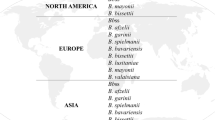Summary
Laboratory diagnosis of Lyme borreliosis is performed by direct detection ofBorrelia burgdorferi in body fluids and tissue samples. This can be achieved by cultivation of the organisms, staining techniques, or demonstration of parts of the genome. Although the best aetiologic proof in case of positivity, these methods cannot yet serve as routine techniques: they are too time consuming and expensive. Currently, the usual method for establishing the diagnosis of Lyme borreliosis is serologic testing (indirect detection). Immunofluorescence, hemagglutination, ELISA tests with whole cell antigen should be considered as screening methods. Assays with selected fractions ofB. burgdorferi antigens or tests using selected recombinant antigens should be considered as more specific. Immunoblotting (Western blotting) may be considered as a confirmatory test. However, the interpretation of test results requires an experienced investigator. Laboratory diagnosis ofB. burgdorferi infections of the central nervous systems (CNS) is the most highly developed method. Demonstration of intrathecally produced specific antibodies, and, moreover, demonstration of specific oligoclonal bands may very well prove the actual infection of the CNS and/or the nerve roots. Seroepidemiological investigations identify neurological manifestations as the most frequent ones among European cases of Lyme borreliosis. The true incidence and prevalence of Lyme borreliosis, however, cannot be determined with current diagnostic methods and must await the development of methods to identify actual infection.
Zusammenfassung
Die Laboratoriumsdiagnose der Lyme-Borreliose erfolgt direkt durch den Nachweis vonBorrelia burgdorferi in Körperflüssigkeiten und Gewebeproben. Dies kann durch Anzüchtung der Organismen, Färbetechniken oder Nachweis von Genombestandteilen erfolgen. Obwohl im positiven Fall der sicherste Beweis, können diese Methoden nicht als Routineverfahren eingesetzt werden; sie sind zu zeitaufwendig und kostspielig. Zur Zeit sind es überwiegend serologische Verfahren (indirekter Nachweis), die zur Laboratoriumsdiagnostik der Lyme-Borreliose eingesetzt werden. Immunfluoreszenz-, Hämagglutinations-, ELISA-Tests mit Ganzzell-Antigen sollten als Suchtests betrachtet werden. Testverfahren mit ausgewählten Antigenen sollten als spezifischer eingeschätzt werden. Die Immunoblot- Technik (Westernblot) kann als Bestätigungsverfahren betrachtet werden, sofern die Interpretation der Ergebnisse durch einen sehr erfahrenen Untersucher erfolgt. Die Laboratoriumsdiagnostik derB. burgdorferi- Infektionen des Zentralnervensystems ist am weitesten entwickelt. Der Nachweis von intrathekal gebildeten spezifischen Antikörpern und von spezifischen oligoklonalen Banden kann mit hoher Wahrscheinlichkeit als Beweis der aktuellen Infektion angesehen werden. Seroepidemiologische Untersuchungen weisen neurologische Erkrankungen der Lyme-Borreliose als die häufigsten unter den europäischen Erkrankungsfällen aus. Jedoch kann die wahre Inzidenz und Prävalenz der Lyme-Borreliose erst ermittelt werden, wenn Verfahren zum Nachweis der aktuellen Infektion verfügbar sind.
Similar content being viewed by others
References
Preac-Mursic, V., Wilske, B., Schierz, G. EuropeanBorrelia burgdorferi isolated from humans and ticks — culture conditions and antibiotic susceptibility. Zbl. Bakt. Hyg. A 263 (1986) 112–118.
Benach, J. L., Bosler, E. M., Hanrahan, J. P., Coleman, J. L., Habicht, G. S., Bast, T. F., Cmaeron, D. J., Ziegler, J. L., Barbour, A. G., Burgdorfer, W., Edelman, R., Kaslow, R. A. Spirochetes isolated from the blood of two patients with Lyme disease. N. Engl. J. Med. 308 (1983) 740–742.
Steere, A. C., Grodzicki, R. L., Kornblatt, A. J., Craft, J. E., Barbour, A. G., Burgdorfer, W., Schmid, G. P., Johnson, E., Malawista, S. E. The spirochetal etiology of Lyme disease. N. Engl. J. Med. 308 (1983) 733–740.
Stanek, G., Klein, J., Bittner, R., Glogar, D. Isolation ofBorrelia burgdorferi from the myocardium of a patient with longstanding cardiomyopathy. N. Eng. J. Med. 322 (1990) 249–252.
Barbour, A. G. Isolation and cultivation of Lyme disease spirochetes. Yale J. Biol. Med. 57 (1984) 521–525.
Barbour, A. G., Burgdorfer, W., Hayes, S. F., Peter, O., Aeschlimann, A. Isolation of a cultivable spirochete from Ixodes ricinus ticks of Switzerland. Curr. Microbiol. 8 (1983) 123–126.
Duray, P. H., Steere, A. C. The spectrum of organ and systems pathology in human Lyme disease. Zbl. Bakt. Hyg. A 263 (1986) 169–178.
De Koning, J., Bosma, R. B., Hoogkamp-Korstnje, J. A. A. Demonstration of spirochaetes in patients with Lyme disease with a modified silver stain. J. Med. Microbiol. 23 (1987) 261–267.
Macdonald, A. B. Human fetal borreliosis toxemia of pregnancy. Zbl. Bakt. Hyg. A 263 (1986) 189–200.
Aberer, E., Stanek, G. Histological evidence of spirochetal origin of morphea and lichen sclerosus et atrophicans. J. Am. Acad. Dermatol. 15 (1986) 406–410.
Rosa, P. A., Schwan, T. G. A specific and sensitive assay for the Lyme disease spirocheteBorrelia burgdorferi using the polymerase chain reaction. J. Infect. Dis. 160 (1989) 1018–1029.
Lebech, A. M., Hindersson, P., Vuust, J., Hansen, K. Comparison ofin vitro culture and polymerase chain reaction for detection ofBorrelia burgdorferi in tissue from experimentally infected animals. J. Clin. Microbiol. 29 (1991) 731–737.
Guy, E., Stanek, G.: Detection ofBorrelia burgdorferi in Lyme disease patients' sera by PCR. J. Clin. Pathol. (in press).
Barbour, A. G., Heiland, R. A., Howe, T. R. Heterogeneity of major proteins of Lyme disease borreliae: a molecular analysis of North American and European isolates. J. Infect. Dis. 152 (1984) 478–484.
Wilske, B., Preac-Mursic, V., Schierz, G., Busch, K. V. Immunochemical and immunological analysis of EuropeanBorrelia burgdorferi strains. Zbl. Bakt. Hyg. A 263 (1986) 92–102.
Stanek, G., Jurkowitsch, B., Köchl, C., Burger, I., Khanankha, G. Reactivity of European and American isolates ofBorrelia burgdorferi with different monoclonal antibodies by means of a microimmunoblot technique. Zbl. Bakt. 272 (1990) 426–436.
Wilske, B., Preac-Mursic, V., Schierz, G., Kühbeck, R., Barbour, A. G., Kramer, M. Antigenic variability ofBorrelia burgdorferi. Ann. N.Y. Acad. Sci. 539 (1988) 126–143.
Wilske, B., Preac-Mursic, V., Schierz, G., Liegl, G., Gueye, W. Detection of IgM- and IgG-antibodies toBorrelia burgdorferi using different strains as antigen. Zbl. Bakt. Suppl. 18 (1989) 299–309.
Luther, B., Moskophidis, M. Antigenic cross-reactivity betweenBorrelia burgdorferi, Borrelia recurrentis, Treponema pallidum andTreponema phagedenis. Zbl. Bakt. 274 (1990) 214–226.
Bruckbauer, H. R., Wilske, B., Preac-Mursic, V., Fuchs, R.: Crossreactive proteins ofBorrelia burgdorferi. Abstracts, IV Internat. Conf. Lyme Borreliosis Stockholm (1990).
Hansen, K., Hinderson, P., Pedersen, S. Measurement of antibodies against theBorrelia burgdorferi flagellum improves serodiagnosis in Lyme borreliosis. J. Clin. Microbiol. 26 (1988) 338–346.
Zöller, L., Burkard, S., Schäfer, H. Validity of Western immunoblot band patterns in the serodiagnosis ofLyme borreliosis. J. Clin. Microbiol. 29 (1991) 174–182.
Author information
Authors and Affiliations
Rights and permissions
About this article
Cite this article
Stanek, G. Laboratory diagnosis and seroepidemiology of Lyme borreliosis. Infection 19, 263–267 (1991). https://doi.org/10.1007/BF01644964
Issue Date:
DOI: https://doi.org/10.1007/BF01644964




